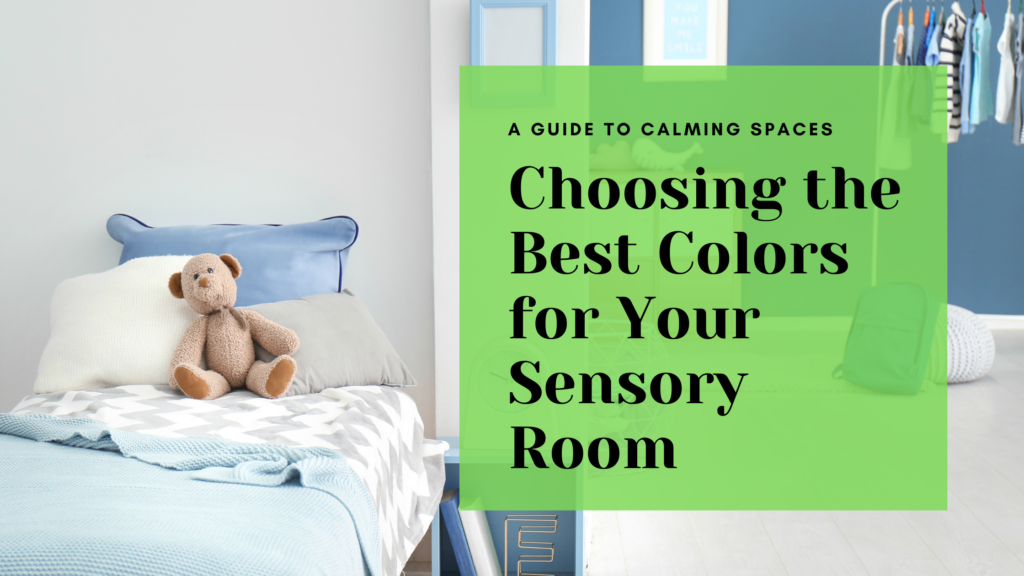I. Introduction
The Importance of Lighting in Sensory Rooms
Lighting plays a crucial role in how we feel and behave, especially for individuals with autism and sensory processing disorders. The right lighting can help create a calming environment, making it easier for people with sensory sensitivities to relax and focus. Sensory rooms are special spaces designed to help individuals manage their sensory needs. In these rooms, lighting can either enhance the experience by soothing the senses or, if not done correctly, overwhelm the individual and create discomfort.
Proper lighting in sensory rooms is essential because it can greatly influence mood, behavior, and sensory perception. For people with autism, certain types of light can be too bright or too harsh, leading to sensory overload. However, with the right lighting, you can create a space that feels safe and comfortable, allowing the individual to thrive.
Purpose of the Guide
This guide is designed to help you understand how to create the perfect sensory-friendly lighting in a room. Whether you’re a parent, caregiver, or educator, the information here will guide you in making the best choices to improve the effectiveness of a sensory room. By carefully selecting and adjusting lighting, you can make a positive impact on the sensory experience, helping those with sensory processing challenges feel more at ease.
II. Understanding Sensory-Friendly Lighting
How Lighting Affects Sensory Perception
Different types of light—natural light, artificial light, and colored light—can have various effects on how we perceive the world around us. For individuals with sensory processing disorders, these effects can be more pronounced. For example, natural light is often calming and can help regulate mood and energy levels. However, too much bright sunlight can cause glare, making the environment uncomfortable.
Artificial lights, such as fluorescent bulbs, can flicker and create harsh, uncomfortable environments. Flickering lights are particularly troublesome for those with autism, as they can cause headaches, stress, and even trigger sensory overload. Reducing glare, avoiding flickering, and controlling light intensity are all important steps in creating a sensory-friendly space.
Choosing the Right Lighting for Different Sensory Needs
People have different sensory needs, so it’s important to choose lighting that can be tailored to those needs. Some individuals might need bright, focused lighting to stay alert and engaged, while others might prefer soft, dim lights to relax and feel safe. Customizable lighting options, such as dimmable lights or color-changing bulbs, allow you to adapt the lighting to suit each person’s preferences. This flexibility is key to creating a sensory room that truly meets individual needs.
III. Types of Sensory-Friendly Lighting Options
Natural Light and Light Control
- Maximizing Natural Light: Natural light is one of the best sources of lighting for sensory rooms. It helps regulate the body’s natural rhythms, such as the sleep-wake cycle, and can have a calming effect. However, it’s important to control the amount of natural light entering the room to prevent it from becoming too intense. Using window coverings, blinds, and curtains allows you to adjust the light levels throughout the day, ensuring that the room remains comfortable.
- Using Blackout Curtains and Blinds: Blackout curtains and blinds are essential for creating a controlled lighting environment, especially in areas designed for rest and relaxation. These tools block out external light sources, allowing you to create a dark, peaceful space whenever needed. This is particularly useful for sensory rooms used as calming retreats, where minimizing light can help reduce anxiety and promote relaxation.
Artificial Lighting Solutions
- Dimmable LED Lights: Dimmable LED lights are a versatile and energy-efficient option for sensory rooms. They allow you to adjust the brightness levels according to the needs of the moment, whether it’s for a calming activity or something more engaging. With dimmable lights, you can create a comfortable environment that adapts to different sensory needs throughout the day.
- Smart Lighting Systems: Smart lighting systems offer even more customization by allowing you to control the lights using a remote or an app. These systems often include features like color-changing options, timers, and preset modes that can help create a specific mood or atmosphere in the sensory room. For example, you can set the lights to gradually dim at bedtime or switch to calming blue tones during a relaxation session.
Color-Changing Lights
- LED Strip Lights and Color-Changing Bulbs: Color-changing lights, such as LED strip lights or color-changing bulbs, are great for creating different moods in a sensory room. These lights can shift through a range of colors, allowing you to select hues that are either calming or energizing, depending on the activity. For instance, cool blues and greens can create a serene atmosphere, while warmer colors like red or orange can be more stimulating.
- Fiber Optic Lights and Projectors: Fiber optic lights and projectors add a dynamic, visually engaging element to sensory rooms. These lights often display soft, changing colors and patterns that can be very soothing to watch. Projectors can cast gentle images onto walls or ceilings, creating a tranquil environment that helps individuals with autism feel more relaxed and secure.
Specialized Sensory Lighting Equipment
- Bubble Tubes and Light Panels: Bubble tubes are tall, cylindrical tubes filled with water and bubbles that rise and fall in a soothing motion. These tubes often change colors, providing both visual and auditory stimulation. Light panels, on the other hand, are flat surfaces that emit soft, glowing light. Both of these tools can enhance the sensory experience by providing interactive visual stimuli that are calming and engaging.
- Interactive Light Tables and Walls: Interactive light tables and walls allow users to engage with light in a tactile and visual manner. These surfaces often respond to touch, lighting up or changing colors when pressed. This interaction not only provides sensory input but also encourages exploration and creativity, making them a valuable addition to any sensory room.
IV. Practical Tips for Implementing Sensory-Friendly Lighting
Creating Zones with Lighting
- Designing Different Lighting Zones: A well-designed sensory room should have distinct zones for different activities, and lighting can help define these spaces. For example, you can use soft, dim lighting in a relaxation corner, brighter lights in an activity area, and color-changing lights in a play zone. By creating these zones, you can help guide the user’s experience and make the room more functional and effective.
- Combining Lighting with Other Sensory Elements: Lighting works best when combined with other sensory elements like sound, texture, and scent. For instance, pairing soft lighting with gentle music and comfortable seating can create a calming area perfect for unwinding. Integrating multiple senses in this way enhances the overall experience, making the sensory room more immersive and supportive.
Adjusting Lighting for Different Activities
- Lighting for Relaxation vs. Stimulation: Different activities require different lighting levels. For relaxation, soft, warm lighting is ideal because it creates a cozy, inviting atmosphere that helps individuals feel at ease. In contrast, brighter, cooler lighting can be used to stimulate focus and concentration during tasks like reading or playing games. Adjusting the lighting to match the activity ensures that the sensory room remains versatile and supportive.
- Adapting Lighting Throughout the Day: The body’s natural circadian rhythm, which regulates sleep and wakefulness, is influenced by light. By adjusting the lighting throughout the day to mimic natural light patterns, you can support healthy sleep habits and overall well-being. For example, bright, cool light in the morning can help wake up the senses, while dim, warm light in the evening can signal that it’s time to wind down.
Safety Considerations for Sensory Room Lighting
- Ensuring Safe Lighting Choices: Safety is paramount when selecting lighting for a sensory room. Choose lights that are non-toxic, durable, and appropriate for the user’s age and abilities. Make sure all electrical components are securely installed and that there are no exposed wires or sharp edges. Additionally, consider the heat output of the lights; LEDs are a good choice because they stay cool to the touch.
- Avoiding Overstimulation with Lighting: While lighting is a powerful tool in sensory rooms, it’s important to avoid overstimulation. This can be done by controlling the brightness, color intensity, and duration of light exposure. For example, limit the use of bright or flashing lights, especially for individuals who are sensitive to visual stimuli. The goal is to create a balanced environment where the lighting enhances the experience without overwhelming the senses.
V. Case Studies: Successful Sensory Room Lighting Designs
Example 1: A Calming Multi-Sensory Room with Adjustable Lighting
In one successful sensory room design, adjustable lighting was used to create a calming environment that could be tailored to the user’s needs. The room featured dimmable LED lights, color-changing bulbs, and blackout curtains, allowing for complete control over the lighting. By combining these elements, the room provided a versatile space that could shift from a bright, active area to a dark, soothing retreat.
Example 2: Using Color-Changing Lights to Enhance Sensory Engagement
Another example showcased the use of color-changing lights to create a dynamic sensory experience. In this room, LED strip lights and a color-changing projector were used to create engaging light displays that could be adjusted based on the user’s preferences. The ability to change the colors and patterns of the lights made the room a favorite place for sensory exploration, offering both stimulation and relaxation as needed.
Lessons Learned
These case studies highlight the importance of flexibility and customization in sensory room lighting. By incorporating adjustable and interactive lighting elements, these rooms were able to meet a wide range of sensory needs, making them both effective and enjoyable for users.
VI. Conclusion
Recap of Key Points
Choosing the right lighting is essential for creating a sensory-friendly room that meets diverse needs. From natural light and dimmable LEDs to color-changing lights and interactive light panels, the options are vast and can be tailored to fit any sensory profile. The right lighting can transform a room into a calming, supportive space that helps individuals with sensory processing challenges thrive.
Encouragement to Experiment with Lighting
Don’t be afraid to experiment with different lighting options to find what works best for your specific needs. Sensory-friendly lighting is not one-size-fits-all, so take the time to explore various combinations until you create the perfect environment.
If you’re ready to start creating a sensory-friendly room, consider reaching out to professionals for advice, exploring additional resources, and sharing your own lighting experiences with others who are also working to create supportive sensory spaces.


